Video x 7mins.
- Brisbane Small Forward Structure
- Brisbane Width
- The Tactic That Won Geelong the Game
Video x 7mins.
Video x 14mins.
Video x 11mins.
Video x 15mins.
6min Video
With 8 games per weekend I'm not sure if I'll get to every game for season 7 but we'll see how it goes!
Here's my 13min film review which looks at tactical and technical slices of the game like I have done in past seasons with all film review posts under the AFLW Film Review stand-alone membership which also contains reviews of all AFLW games from season 6/2022.
Full study link here.
Full Study Link Here.
Full study link.
This week I'll posting my notes from numerous studies that I've read over the last little while, of which I've done in some previous posts.
There's barely any of these studies specific to Aussie Rules Football but one's like these related to soccer and Gaelic football carryover easily.
They'll mostly be long (today is the shortest one) and disjointed as they're my notes taken based on my current level of understanding so it won't tell the entire story but if you find a nugget or 2 that takes your liking then here's the link to read up further on them, which also has various diagrams on study conditions etc that might be of interest
Handy hint- these study documents are great public transport trips.
Let me know your thoughts and/or any clarification you require on any of these points.
As I've mentioned previous times before, and what you may have noticed yourself, is that at local footy teams will defend with more players than they attack with most of the time,meaning they'll have extra's behind ball before they have extra's in front of the ball.
This is great for reducing the opposition from scoring but it can often undo your own ability to score as your outnumber advantage in 1 part of the ground results in an outnumber disadvantage in the other.
Last year the Sydney Swans mastered the ability to outnumber the opposition in multiple parts of the ground in the same play, taking it to a whole different level this year with forward pressure with how they use all 18 players on the ground in regards to specific positioning when their is a stoppage in a specific part of the ground and then how they move once ball is on the move.
This game/training scenario takes a slice of the game (as they all do) of defending with many more payers then the offensive are trying to score with and literally plays out as the game video shows.
Also within the game video I point out a few ways the Saints could have played out this scenario for a more sustainable method of transition offense and you can use these with your own players but if you do, keep them to yourself initially and try and guide them towards those solutions.
Give them some goes at this with no instruction, let them have a short discussion about how to better what they're doing, give them some goes at it and then if they're not edging towards what you think is more sustainable and closer to your normal game method, that's when you, the coach, come in as a facilitator of the environment with questions of why they are doping it this way, how else could they be doing it, what affordances are consistently arising in this scenario etc, edging towards your, or my, solutions.
GAME MOMENT...
For full access to this game/training scenario and many others that you can use with your own team, register for a level 4 membership at https://aussierulestraining.com/membership-account/membership-levels/.
With finals right on our doorstep (not mine unfortunately!) there's not much more as coach that you can do in regards to team tactics/strategies or individual physical conditioning between now and the Grand Final.
Hopefully since December last year you have been able to instill all the team tactics and strategies you want and need to hit the last game of the year and now it's a matter of constant checking for understanding among the playing group on an individual and team line basis.
When players are well aware of their individual and team roles and responsibilities then your job as coach is pretty much done - it's in the players hands now, and that's where you want to be at this time of the year.
Once that has been achieved then it's all a psychological game on which team of individuals can carry out their collective tasks over 4 quarters and this is where confidence comes in.
When 2 teams are playing are playing against each other with equal tactical, strategic and physical abilities, the team who can execute those qualities with more confidence will win.
A quick example of this is both teams adapt at switching the ball from the back line where q team goes all the way around the boundary line to their forward line in 5 - 10 possessions in 20 - 30secs compared to the team that switches the ball but then bites off an in-board kick that straightens them back up and enables them to hit their forward line in 3 - 6 possessions in 10 - 20secs.
The coach really needs to know his players at this point to ensure every single player is beaming with confidence of what they can do individually and collectively against the best opposition.
Here are some things to look for thanks to Dan Abrahams, a coach I've referenced more times than I can remember in my content.
What To Look For
Players looking lethargic, hiding, looking lost, reacting with stronger than normal emotion, are being quieter than normal and making uncommon errors for them.
What Are They Going Through
They are mentally rehearsing failure in their heads so ask them to recall their best game and remind them of moments of success in the not so distant past and ask them what their biggest supporter would say about their game when they are at their best.
What Can You Do
They are in dire need of certainty of instruction so ask questions to clarify what they know, explain your points in a simple and concise way, come back to them later in the week and test their understanding then retest again close to game time.
Another method you can use is to help them pick the 2 -3 most important tasks that they can focus on and help them make them specific and controllable.
Helping them with positive, helpful and energising self talk to squash automatic negative thoughts and insisting on great body language are also psychological boosting factors you can turn to.
About a month ago I posted about the 3 zones of football and how you could use it to guide your training more specifically than you currently do and today we're going to have a look at how to that in regards to training to apply huge forward pressure which gives you increased game time in your own forward half time, keeps the ball closer to your goal then the opposition's and allows your backs to defend up to high to lock that sucker in.
What the 3 zones of football does is allows you to create similar scenario's to what happens in a game where players get to the ball location at all different times rather then at training where everyone gets there at the same time as they're already in perfect positions to contest the ball but a huge part of positioning is knowing when and being able to get there at the absolute right time and this will help greatly with that.
Traditional training also focuses a lot on one 1 and 2 and not much on zone 3 which is your team structure zone which is your foundation so it will also give your players plenty of opportunities to see this in a low pressure situation allowing them to make better decisions instead of seeing it for the first time in a game when cognitive function is highly compromised and sub-par decision making is the result.
As the title suggests we're going to look at applying forward pressure under different conditions, conditions that forwards will see multiple times during a game.
There are 5 levels to this full activity that don't need to be implemented all on 1 night is not meant to be but going 2 - 3 levels at a time is probably the right choice, depending on your forward's success level.
LEVEL 1...
For full access to this training activity and many others register for a level 3 membership at https://aussierulestraining.com/membership-account/membership-levels/.
This scenario is taken from an actual game but is really a multi-part play consisting of:
1 - Defensive Transition Positioning to Create Enticing Teasing Distance
2 - Offensive Transition Positioning to Create Enticing Pass Option + Engage Multiple Defenders Around You
This will present itself in a game at various times but it's also a product of your team's game plan and if defensively you want to provide teasing distance to try and pick off missed corridor kicks or offensively, to pick apart defenses by filling in gaps between their lines.
I'm going to go against the grain of these scenario's a bit and make this more "drill-y" then usual and which I'll lose sleep over but that's my problem!
I'm going to reproduce a slice of this scenario in a pre-determined fashion so it won't involve players recognising these formations in a game nor their ability to run to these positions at the right time.
Regardless this type of kick, usually a 1 step, low and hard kick , is definitely one worth training as it can speed up your ball movement quite dramatically without needing any major game style overhauls.
Here's how it all looks:
GAME MOMENT...
For full access to this game/training scenario and many others register for a level 4 membership at https://aussierulestraining.com/membership-account/membership-levels/.
This game/training scenario piggy backs off off from yesterdays lengthening the ground scenario bit in the maybe the most important spot on the ground to get right.
The kick inside forward 50 is the most critical kick in football but that can be set up by what you do with the ball and your players between the arcs.
This scenario takes the starting point of the players in the video but then presents multiple options for the ball carrier, some of which will gain an advantage for their team and others that won't.
There is no 1 way to solve this problem but your aim is to definitely play at the pace that you need to as your teammates work themselves into better attacking positions...
For full access to this game/training scenario and plenty of others register for a level 4 membership at https://aussierulestraining.com/membership-account/membership-levels/.
In 2022 footy is played completely different how it used to be played in 80's and 90's when I was a kid.
The disappointing this is that it's still often coached that way and nuances of the game that were evident back then have faded out of the game as new ball/player movement tactics have evolved to suit the modern game.
Lengthening the ground is one of those nuances.
Back in the golden days you were taught to constantly hit up at the footy, which is still required today in some cases, bit nowhere near as much as it used to be.
Leads are more lateral these days as footy uses far more ground space then it used to with switch of plays and kicking off the line rather then long down for territory.
This also comes back to the kicker too as there is a greater focus on maintaining possession of the ball for as long as you can over territory kicks to 50/50's.
On top of that there is far more room for error kicking to lateral leads then there is to front on leads coming straight at you.
Perhaps the biggest issue with straight on leads is that you can get yourself out of position very quickly leaving less players ahead of the ball and more work required to get up and then back again, often against an outnumber, especially when multiple players all lead up at the footy.
Let's move into the 2020's with this lengthening scenario...
For full access to this game/training scenario and many others register for a level 4 membership at https://aussierulestraining.com/membership-account/membership-levels/.
Today marks 2 years since the old man passed away suddenly and posted at the time how he was me my 3 brother's greatest supporter in all our sporting endeavors.
While cleaning out his flat at the time we came across the game stats he used to take for all us for every game of football we played at Dennington Football Club down in Warrnambool, Jordan Lewis' junior club.
Sometimes he'd even take some senior player stats after our junior games where in 1 elimination final 1 bloke (Stephen "Worm" Williams) totaled 52 possessions and a goal in an elimination final win, the club's first final (and win) since the late 80's.
Anyway here are 8 of games from 1993 aged 14 for that season through to 1997, aged 18 for that season.

I used to be a pretty sore loser so with 26 touches and a goal all resulting in 2pt loss when wins were extremely rare, must have made me extra grumpy post-game.

This year I was 15 (my birthday is Sep 29th so I was always the youngest, just 2 days fro the cut off date) and would have weighed 40kgs but had to play under 18's anyway with 2 of my brothers that year. This was a preliminary final in the wet for memory and you can see all the extra add-on's from the old man who loved his game notes every now and then. My brother Jarrod, who had been invited to the Geelong Falcons this year I reckon, played pretty much his last game of footy ever in this one after dislocating his shoulder and we got flogged the next week in the Granny with an all in brawl to boot - good time!

2 out of 4 goals but a good old fashioned flogging as was the go back then.
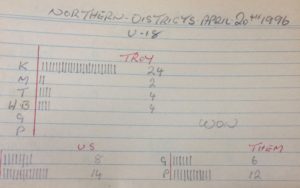
Not sure how we won this as we wouldn't have been very good again that year and Districts were only a year or 2 away from moving to the much stronger Hampden league but we'll take it.
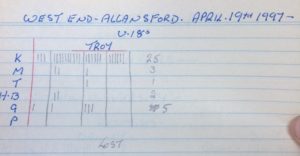
In 1997 I was 18 for the entire year, again with my 19th birthday not until after the season was completely finished and was a pretty successful year as we made finals that year, a rarity for the Dogs and 5 goals is my 2nd best return for entire game, after the 8 I managed about 20 years later!
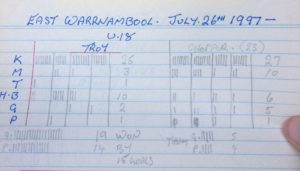
Fortunately for us we were only the 2nd worst team most of the time in juniors so at least we had East Warrnambool twice a year to get some wins against with Chopper also having a day out.
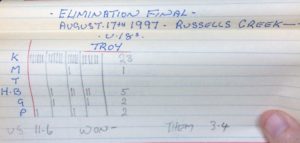
We hated Russell's Creek more than anyone and we rarely beat them so do so in an elimination final was absolute gold although I always remembered kicking 5 in this game but the old man's stats don't lie!
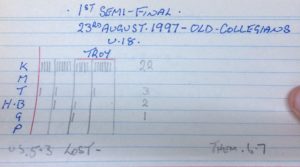
This was the week after the highly fancied Old Collegians, who I eventually ended up playing for from 2000 - 2004 before moving to Melbourne. This was a simply terrible day in constant rain, wind and mud and I reckon they kicked a goal with about 10secs to go, it was a nail biter down to the end and we were shattered to lose to be honest as we'd battled all year to just get a team together let alone win a final and come this close to a 2nd one.
So there's a little trip down memory lane, love ya Dad.
